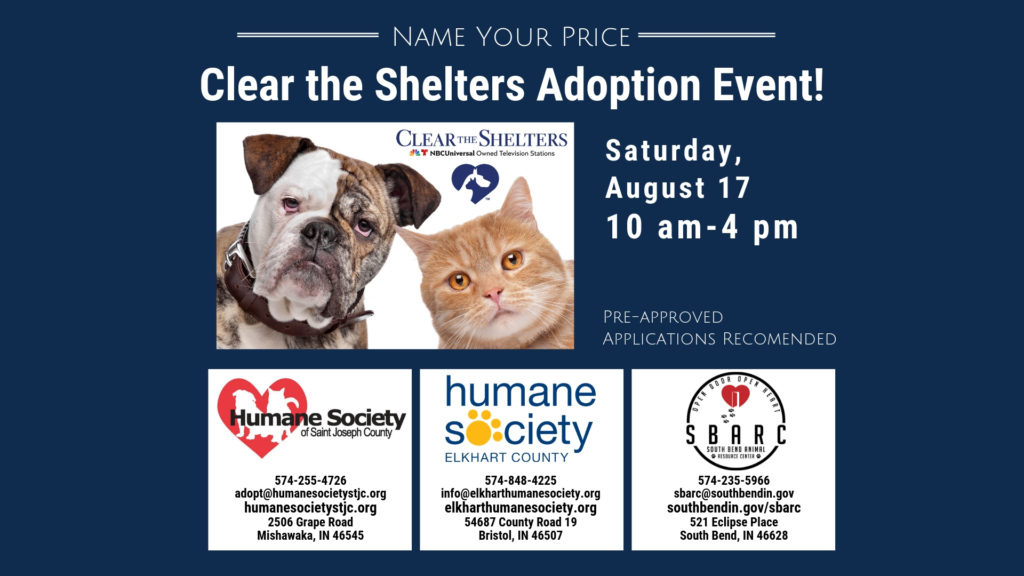Have questions about adopting a HSSJC pet? Check out these common questions and answers below. You can also check out our ADOPT page for procedures, adoption programs, and fees. If you still have questions feel free to call or email us!
Will I need to take my new pet to the vet?
Yes. Shelter pets come with a one week health guarantee as long as you do a wellness exam with your veterinarian in the first week after adopting. Even though we have provided your new pet with their vaccinations and basic testing, we are limited in the resources and treatments we can provide.
What vaccinations will my new pet have?
Our canines come with a distemper/parvo, bordetella, deworming and rabies vaccination for dogs over 12 weeks. If old enough they have been tested for heartworm disease. Both dogs and cats are microchipped and are spayed or neutered before going home. Felines receive a vaccine that prevents Feline Rhinotracheitis, Calicivirus, and Panleukopenia, deworming and rabies vaccination for cats over 12 weeks. Felines have also been tested for FIV/Felv. You will receive a copy of all vaccinations and medical information at the time of adoption. It is highly suggested you take a fecal sample from your new pet to your veterinarian to check for internal parasites.
Can my dog at home meet the dog I’m interested in?
Once your application has been approved an Adoption Specialist will give you a call to set up an appointment for a Meet & Greet. During this appointment we will introduce your dog to our shelter dog.
Will my new pet be potty trained?
Our staff works hard to keep the shelter pets on a regular schedule to play and exercise in large indoor and outdoor runs. Volunteers come in daily to take the dogs on walks as well. However, your new pet may need some refresher courses in potty training. We suggest keeping your new dog on a consistent schedule and taking your pet out on a leash (even if you have a fenced in yard) to the same part of the yard each time. Once the animal goes potty immediately make it a big celebration and give your new pet a treat while still outside. This will help reinforce the good behavior of going potty outside.
Does my new pet get along with children or other animals?
We do not always have a complete background history on each of the animals as the majority of them come to us as strays. Each canine’s behavior and temperament are assessed. Restrictions may be put on a certain dog based upon the behavior assessment findings.
What tips do you have for introducing my new cat/kitten to my home?
Introducing Your New Cat/Kitten to Their Home
Whether you have chosen to adopt a cat or a kitten, it is VERY important to do a proper introduction on their arrival to their new home. The following are a few tips to make the transition from shelter life to home life easier for your new feline and your family.
ADJUSTMENT TIME
It is important to take things slowly and is best to restrict your new feline to one room away from other pets in the home. Be sure to interact with them and provide them the necessities; food, water, litterbox and a soft place to lay. How long your cat should be restricted depends on their personality but they will typically let you know when they’re ready to explore the rest of their new home. Doing this ensures they know the location of their new litterbox and gets them used to the new smells and noises of their home.
SCRATCHING
Keeping your cats’ nails trimmed will be of great benefit to you and your furniture!
If you’d like our Cattery Attendant to show you how to use cat nail clippers, please ask. Cardboard scratchers are another inexpensive way to curb scratching and cats love them! We do not recommend declawing. Before considering declawing please visit the following resources:
American Veterinary Medical Association – http://tinyurl.com/h2f2ken
Best Friends – http://bestfriends.org/resources/cat-declawing-price-convience
Humane Society of the United States – http://www.humanesociety.org/animals/cats/tips/declawing.html
LITTER BOX
Cats instinctively look for a safe place to go to the bathroom in which they can cover their urine and feces. The most important thing to do is keep the litter box clean! Litter boxes are recommended to be scooped at least once a day. Place litter boxes in low traffic, quiet areas. The rule of thumb for number of litter boxes is to have one box for each cat in the home, plus one.
Supplies
- Food & Water Bowls – Stainless steel or ceramic are recommended as plastic can harbor dangerous bacteria.
- Collar – Breakaway (safety collars) should be the only type of collar you put on your new cat.
- Grooming Tools – The length of your new cat’s hair depends on the type of brush or comb. Nail clippers are also an important grooming tool.
- Litter Box & Litter Scoop – A high-sided litter box with a lid is recommended. It is important to have one litter box for each cat in the home plus one additional. Exp, 2 cats in the home should have 3 litter boxes.
- Litter – Clumping litter is easy to scoop and has less dust.
- Carrier – There are many types of carriers but as long as it’s secure any carrier will work for taking your pet to the veterinarian.
- Food/Treats – Always discuss how much food you should feed your cat with your veterinarian.
- Toys – Interactive toys to keep your new cat entertained are great for their health.
- Scratching Post – Cats need a place to scratch and to help prevent scratching on furniture it is important to provide them an alternative.
- Veterinarian – Make sure to find a veterinarian you trust and feel comfortable discussing your new cat’s health with.
What is the adoption process like?
Visit our ADOPT page for more information on the adoption process, fees, and other important adoption info.
How much does it cost to adopt a pet?

 Canine adoption fees are $200.00. Purple Collar Club members are seniors or special needs dogs with a reduced adoption fee of $50.00. Kittens under one year old are $75.00, cats 1-7 years old are $50.00 and senior cats ages 8+ have no fee at all. Take part in our Adopt-A-Buddy program where the adoption fee for a second feline friend is waived! Check out the Adopt page for more information on Pocket Pet adoption fees.
Canine adoption fees are $200.00. Purple Collar Club members are seniors or special needs dogs with a reduced adoption fee of $50.00. Kittens under one year old are $75.00, cats 1-7 years old are $50.00 and senior cats ages 8+ have no fee at all. Take part in our Adopt-A-Buddy program where the adoption fee for a second feline friend is waived! Check out the Adopt page for more information on Pocket Pet adoption fees.
You will also need to budget for other items your new pet may need. Some examples include a dog crate, cat carrier, appropriate cage for pocket pets, bowls, collar, leash, Gentle Leader or Easy Walk Harness, obedience training, wellness check at a veterinarian, flea and tick preventative, toys and treats. Don’t forget your new pet will need wholesome food too! Our adoptable dogs and cats have been fed a diet of Well Pet and Eagle Pack products.
What should I bring with me when I come to pick up my new pet?
If you’re adopting a dog you will need to bring a leash and collar. Gentle Leaders are highly suggested for medium and large size dogs. Cats will need to be transported in a secure carrier. The shelter does sell cardboard cat carriers for $5.00. All animals must be transported in a safe and humane manner to their new homes. Dogs cannot be loose in the bed of a truck and cats must be in a carrier.
What type of food do the shelter pets eat?
Our adoption pets are fed Eagle Pack and Wellness brand dry foods. You can purchase this food at Pet Supplies Plus in South Bend and Paw Mart in Granger and Mishawaka.
What if it doesn’t work out, will I get a refund?
Each animal is given a 7 day health guarantee as mentioned above. A refund will be given if your veterinarian discovers a health concern and recommends that the animal should be returned to the shelter within the first 7 days after adopting. Refunds are not given for temperament or behavior issues including the animal not getting along with other pets in the home.



